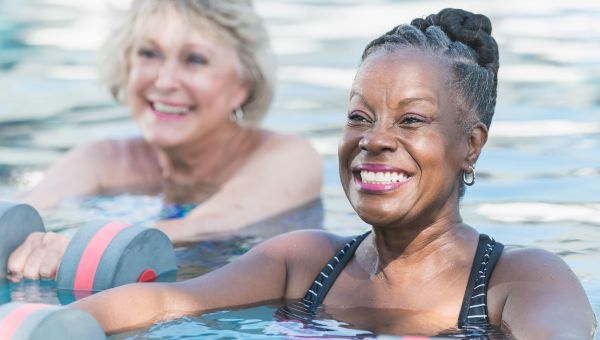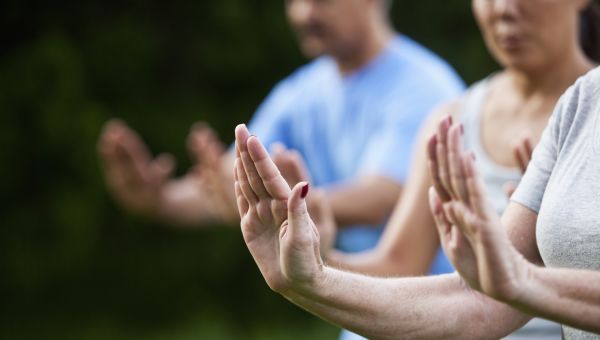5 Drug-Free Ways to Ease Fibromyalgia Pain
Here's how to relieve symptoms without medication.
Updated on February 15, 2023

Everyone has occasional aches and pains. There are many reasons for this periodic discomfort, and it can be a part of getting older. But what if they're something more? What if it seems like the pain is throughout your entire body? And what if all of your X-rays, blood tests, and MRIs show that there’s nothing wrong?
It could be fibromyalgia, a chronic pain condition that’s challenging to diagnose and difficult to treat. Standard treatment options for fibromyalgia often involve taking medication, though some treatments focus on lifestyle changes.

Do I have fibromyalgia?
“Fibromyalgia is a poorly understood pain disorder,” says Lela Mansoori, MD, a hospitalist and endocrinologist with Presbyterian St. Luke’s Medical Center in Denver, Colorado. “Patients can experience pain, fatigue, stiffness, and non-restorative sleep.”
There are no blood or imaging tests to diagnose fibromyalgia, and because of this, some healthcare providers believe this collection of symptoms could be caused by stress, depression, or PTSD, says Dr. Mansoori. Nevertheless, “there’s little doubt those symptoms are real, and there’s a need to help relieve them.” Many experts believe that people with fibromyalgia experience abnormal pain perception processing, meaning they’re more sensitive to pain than those without the condition.
While there are a number of drug treatments available—and you should always take medication as prescribed by a provider—the following therapies may help relieve symptoms.

Aerobic exercise
Many people fibromyalgia are physically inactive, causing them to become deconditioned. What's more, explains Mansoori, the pain from fibromyalgia can create a vicious cycle—your body hurts so you don’t want to exercise, which leads to deconditioning and stiffness, causing your body to hurt more.
Fortunately, physical activity may help. “There is strong scientific evidence that aerobic exercise helps stop the cycle and improve chronic pain and fatigue,” she says. For example, a 2017 review of 13 studies published in the Cochrane Database of Systematic Reviews found that aerobic exercise is tied to improved health-related quality of life and may lower the intensity of pain.
A healthcare provider can recommend a fitness routine that works for you. Walking, biking, swimming, and water aerobics are often good options, Mansoori says.

Cognitive behavioral therapy
Cognitive behavioral therapy (CBT) is another viable, non-drug treatment for fibromyalgia symptoms. A 2018 review of studies published in the European Journal of Pain found that CBT helps people with fibromyalgia with pain relief as well as reducing negative mood and fatigue, and is just as safe as standard treatment.
“Patients with fibromyalgia have a heightened pain sensitivity, and there is good data to show that when a patient is under psychological and emotional stress, pain perception and sensitivity can be heightened even more,” Mansoori says.
“The thought is that when patients learn cognitive behavioral tools to lower stress, they can raise their pain threshold.” Mansoori says CBT combined with aerobic exercise has been shown to be more helpful than CBT alone.
One variety of CBT that has also seen some success is CBT combined with biofeedback (BF), where the physical responses of the person undergoing therapy—such as their muscles tensing—are monitored and reported back to them with a sound or a light. A 2022 study published in Health Psychology Open compared CBT alone to CBT with BF in patients with fibromyalgia and found that both were effective, but in different ways. CBT on its own improved anxiety and quality of life, while CBT with BF reduced fatigue.

Meditation
A 2020 survey published in Pain Management Nursing found that 66 percent of respondents with fibromyalgia used complementary or alternative treatments—and of these, meditation was one of the most common. While evidence of the effectiveness of meditation for pain management has been mixed, research suggests the ancient practice may have some benefits.
Mindfulness is a meditative practice that emphasizes focusing on your experience in the present moment. One 2019 study published in Clinical Rheumatology found that mindfulness helped lower the overall impact of fibromyalgia on a person’s life and also helped fibromyalgia-based anxiety.
A 2020 review of studies published in Comparative Effectiveness Review also found that mindfulness practices can be as effective as CBT for reducing fibromyalgia pain for 6 to 12 months, and can improve a person’s ability to perform daily activities.

Tai chi
Tai chi, a Chinese martial art that combines meditation and gentle exercise, can help relieve fibromyalgia-related pain.
“Tai chi is a very gentle exercise that involves meditation as well as flowing circular movements, balance and shifting of weight, breathing techniques, imagery and focused awareness,” says Mansoori.
A 2019 review of six studies in Complementary Therapies in Medicine found that tai chi has more positive effects for people with fibromyalgia than standard care. It found evidence that the practice helps with pain, improves sleep quality, reduces fatigue, helps with depression, and enhances physical and psychological quality of life.

Flexibility training
Training such as yoga and Pilates can be helpful for people with fibromyalgia, reducing muscle stiffness, pain, and tenderness, and increasing strength and flexibility.
“If a patient with fibromyalgia has been exercising aerobically about three times per week for six months, then I would recommend adding Pilates or yoga to strengthen the core and improve total body joint flexibility,” Mansoori says.

Centers for Disease Control and Prevention. Fibromyalgia. Page last reviewed January 6, 2020.
NIH: National Institute of Arthritis and Musculoskeletal and Skin Diseases. Fibromyalgia: Diagnosis, Treatment, and Steps to Take. Last reviewed June 2021.
American College of Rheumatology. Fibromyalgia. Page last updated December 2021.
Bidonde J, Busch AJ, Schachter CL, et al. Aerobic exercise training for adults with fibromyalgia. Cochrane Database Syst Rev. 2017;6(6):CD012700.
Skelly AC, Chou R, Dettori JR, et al. Noninvasive Nonpharmacological Treatment for Chronic Pain: A Systematic Review Update. Rockville (MD): Agency for Healthcare Research and Quality (US); April 2020.
Bernardy K, Klose P, Welsch P, et al. Efficacy, acceptability and safety of cognitive behavioural therapies in fibromyalgia syndrome - A systematic review and meta-analysis of randomized controlled trials. Eur J Pain. 2018;22(2):242-260.
Govillard L, Gorbeña S, Iraurgi I. Cognitive behavioral therapy with and without biofeedback in fibromyalgia: Assessment of functional and clinical change. Health Psychol Open. 2022;9(1):20551029221106044.
Pfalzgraf AR, Lobo CP, Giannetti V, et al. Use of Complementary and Alternative Medicine in Fibromyalgia: Results of an Online Survey. Pain Manag Nurs. 2020;21(6):516-522.
Pleman B, Park M, Han X, et al. Mindfulness is associated with psychological health and moderates the impact of fibromyalgia. Clin Rheumatol. 2019 Jun;38(6):1737-1745.
Skelly AC, Chou R, Dettori JR, et al. Noninvasive Nonpharmacological Treatment for Chronic Pain: A Systematic Review Update. Comparative Effectiveness Review. 2020;227.
Wang C, Schmid CH, Fielding RA, et al. Effect of tai chi versus aerobic exercise for fibromyalgia: comparative effectiveness randomized controlled trial BMJ 2018;360:k851
Cheng CA, Chiu YW, Wu D, et al. Effectiveness of Tai Chi on fibromyalgia patients: A meta-analysis of randomized controlled trials. Complement Ther Med. 2019;46:1-8.
Lazaridou A, Koulouris A, Dorado K, et al. The Impact of a Daily Yoga Program for Women with Fibromyalgia. Int J Yoga. 2019;12(3):206-217.
de Medeiros SA, de Almeida Silva HJ, do Nascimento RM, et al. Mat Pilates is as effective as aquatic aerobic exercise in treating women with fibromyalgia: a clinical, randomized and blind trial. Adv Rheumatol. 2020;60(1):21.
More On


video

article

slideshow


video


video
